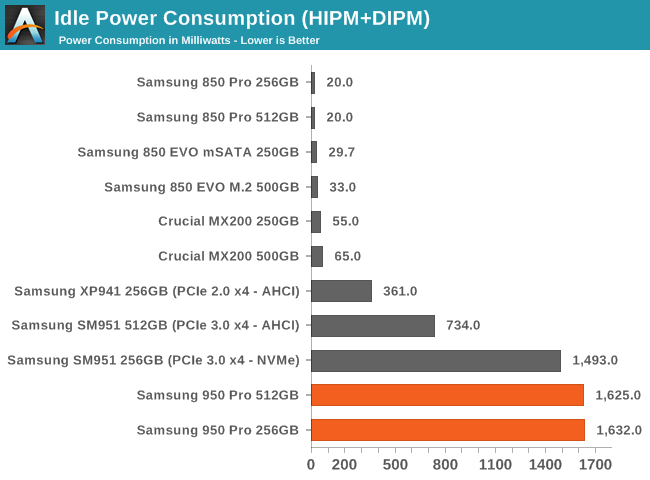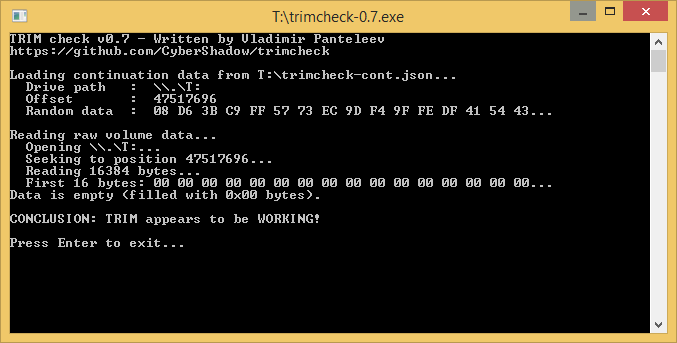The Samsung 950 Pro PCIe SSD Review (256GB and 512GB)
by Billy Tallis on October 22, 2015 10:55 AM ESTIdle Power Consumption
The idle power consumption I'm reporting here and in the Bench database is what's achievable on our 2015 testbed with PCIe ASPM disabled for the sake of system stability. Samsung's initial announcement of the 950 Pro specified an idle power consumption of 1.7W, which these drives manage to stay under. Samsung's later specs mention 70mW idle and 2.5mW DevSlp power draw. The former figure is something we hope to be able to verify in the future, but our power meter isn't sensitive enough for measuring DevSlp power.

As stated earlier, the power numbers for the PCIe drives are more of a worst-case scenario, due to our testbed being unable to enable their power saving modes. These active idle power levels have nevetheless been growing with each new PCIe drive from Samsung.
Trim Validation
Strictly speaking, NVMe doesn't have the TRIM command. The NVMe Deallocate command is the equivalent to the ATA Trim command, and since the trimcheck tool relies on the OS and filesystem to issue the command, it works without modification on NVMe drives.











142 Comments
View All Comments
bill.rookard - Sunday, October 25, 2015 - link
VERY interesting. Of particular note is the Crucial MX200 - an older drive, and connected via SATA which trades blows back and forth with the newer PCIe - nvme based drives. Wow, good stuff.Deders - Thursday, October 22, 2015 - link
I think it was only PCIe drives that had long booting times like the Intel 750.Gigaplex - Thursday, October 22, 2015 - link
These are PCIe drives.Deders - Friday, October 23, 2015 - link
I mean slotted drives as the drive controller has to load from the deviceKristian Vättö - Thursday, October 22, 2015 - link
I have a 256GB 950 PRO in my system (AsRock Z170 Extreme 7) and boot time is about 8 seconds with ultra fast boot enabled in BIOS/UEFI.Jacerie - Thursday, October 22, 2015 - link
Why would you go on about how awesome Skylake and the 100 series chipset are for PCIe connected drives and then use a Haswell chip and a Z97 board for the test rig? Time to go back to the bench.Billy Tallis - Thursday, October 22, 2015 - link
The Haswell system is what I've got on hand to test with, and it's what allows my results to be directly comparable with the reviews from earlier this year.Skylake gives you PCIe 3 from the PCH, but on the testbed we always use an x16 slot directly off the CPU for PCIe SSDs, so we don't need Skylake to run the drive at PCIe 3 speeds.
Jacerie - Thursday, October 22, 2015 - link
Will you be posting a follow-up to highlight any controller differences with the newer hardware?MrSpadge - Thursday, October 22, 2015 - link
This is not a SATA controller we're talking about, it's PCIe. And there we have hardly seen any differences between different implementations over the years.hansmuff - Thursday, October 22, 2015 - link
May I humbly request an addition to the review to show performance AND issues when using a PCI Express 2.0 to M.2 adapter on an older platform like the P67A?